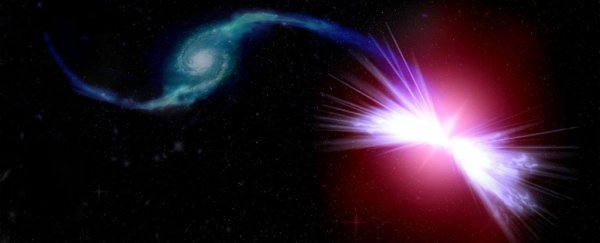An international team of scientists appears to have solved a longstanding mystery in astronomy, identifying the potential cause of what turns galaxies from vibrant, star-producing systems into regions of space where no new stars are born.
According to the researchers, this phenomenon – called quenching, where galaxies cease to create new stars – might be caused by low-energy supermassive black holes, which produce interstellar winds of such heat and intensity that they suppress the ability of stars to form throughout whole galaxies. And the team thinks that galaxies containing these kinds of supermassive black holes – called 'red geysers' – could be quite common, suggesting that lots of star systems are now effectively dormant as a result.
If the findings are confirmed, it's a major discovery, with this 'galactic warming' explaining one of the major disparities of the Universe: what it is that separates active galaxies from sleeping or 'quiescent' star systems?
"Stars form from [gas], a bit like the drops of rain condense from the water vapour," said one of the team, astrophysicist Michele Cappellari from Oxford University in the UK. "And in both cases one needs the gas to cool down, for condensation to occur. But we could not understand what was preventing this cooling from happening in many galaxies."
Given so many quiescent galaxies have enough gas within them to keep producing new stars, the researchers knew something else had to be responsible for inducing this sleepy state – but until now, nobody knew what exactly that was.
"It was like having deserts in densely clouded regions," said one of the researchers, Edmond Cheung from the University of Tokyo in Japan. "We knew quiescent galaxies needed some way to suppress star formation, and now we think the red geysers phenomenon may represent how typical quiescent galaxies maintain their quiescence."
The team thinks that old galaxies known as red geysers – so-called because they're lacking in bright, blue young stars – are transformed from active galaxies due to the pull of supermassive black holes.
In the artist's impression above, you can see an example of the phenomenon, with galactic warming occurring through the interaction of two distant galaxies, affectionately nicknamed by Cheung as Akira (on the right) and Tetsuo (on the left).
A supermassive black hole at the centre of Akira sucks gas from neighbouring Tetsuo, and the intense wind forces generated in the process raise the level of heat in ambient gas throughout Akira, suppressing the birth of any new stars and turning the system into a red geyser.
While scientists had previously thought that this kind of gas motion might be a possibility, this is the first time anyone has observed the phenomenon first hand.
"The discovery was made possible by the amazing power of the ongoing MaNGA galaxy survey," said lead researcher Kevin Bundy from the University of Tokyo. "The survey allows us to observe galaxies in three dimensions, by mapping not only how they appear on the sky, but also how their stars and gas move inside them."
The MaNGA survey is the largest of its kind, and is currently in the process of mapping the details of 10,000 nearby galaxies, charting not just the supermassive black holes at galaxy centres, but their edges as well.
"Since MaNGA studies so many galaxies, our snapshots can reveal even the quickest changes to galaxies," said one of the team, Renbin Yan from the University of Kentucky. "And that's how we found Akira."
